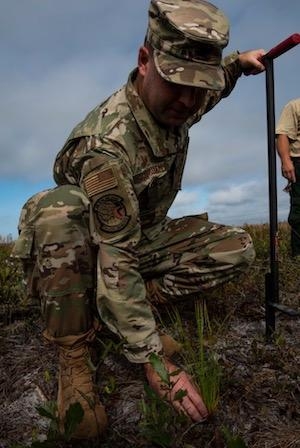Replacing Trees Destroyed By Hurricane Michael In October 2018
On Jan. 15, Tyndall Air Force Base Airmen, the 325th Civil Engineer Squadron natural resources section and contracted partners began planting Longleaf pine trees along U.S. Highway 98 in the Florida Panhandle. This is a partnership between Air Force service members, Department of Defense contracted employees and representatives of the U.S. Fish and Wildlife Service.

“This year, we will be planting 475,000 trees over 700 acres,” said Jose Cintron, 325th CES environmental element chief. “These trees will be approximately (one foot) tall and we plan to begin planting along the south side of Highway 98.”
The aftermath of Hurricane Michael in October 2018 left an immense amount of downed trees, uprooted shrubbery and other debris scattered across Tyndall AFB’s 18,000 acres of forested land. “I felt helpless,” said Dann Childs, 325th CES base forester. “I felt that everything that had been accomplished for the forestry program over the last 27 years had been destroyed. My background is in wildland fire and forestry, but I knew the implications to the environment would be serious”
“I was completely heartbroken,” said Melanie Kaeser, U.S. Fish and Wildlife Service liaison to the 325th CES. “Just seeing the visual of the damage and destruction and not knowing how we were going to move forward was hard.”
The DoD awarded contracts to companies and local businesses to come in and help with debris removal. “If you had just walked away and not removed the downed trees and forest debris, nature would have responded to recover,” Childs said. “So we are trying to steer that in a direction that is historically part of the base’s ecological system while also using a more resilient species of tree that also serves the military mission.”

“From a mission standpoint, the well managed Longleaf pine forests offer a pristine training area,” Kaeser said. “The longleaf is very beneficial to the mission because it is applicable to a controlled fire environment. When Longleaf pine forests are managed with low-intensity frequent fire, the result is an overstory of Longleaf pine trees. In turn, frequent fire reduces the risk of catastrophic wildfires.”
If the installation would have allowed invasive and opportunistic species of plants and trees to start growing on base, there would have been a significant potential for high intensity wildfires, according to Childs.
The Longleaf pine trees are fire tolerant, resulting in an ecosystem that is easily managed with prescribed fire, and is easier to reintroduce back into the area as opposed to some other pines. “The Longleaf pine will create a better and more well managed recreational area and offer a better habitat for other plants and animals,” Kaeser said.
Accomplishing this ambitious plan to positively impact Tyndall AFB’s forestry is no small feat. The plan is broken down into three phases of action. “It will take about three to four years to plant the longleaf, but (it) will require 35 to 45 years before we reach our goal of a fully functioning ecosystem,” Kaeser said.
To date, 7,500 acres of Tyndall AFB’s land has been cleared of forest debris, and what was removed has had a positive impact to the community. Almost all of the 150,000 tons of decries has been utilized at our local paper mill in Parker, Fla., to make paper and power the plant.
The target is to ultimately clear around 10,000 acres, Childs said.
Now that most of the debris has been cleared, the base can start moving forward by planting trees back onto the land.
(Images provided with USAF news release)
 ANN's Daily Aero-Linx (04.15.24)
ANN's Daily Aero-Linx (04.15.24) Classic Aero-TV: 'No Other Options' -- The Israeli Air Force's Danny Shapira
Classic Aero-TV: 'No Other Options' -- The Israeli Air Force's Danny Shapira Aero-News: Quote of the Day (04.15.24)
Aero-News: Quote of the Day (04.15.24) Airborne 04.16.24: RV Update, Affordable Flying Expo, Diamond Lil
Airborne 04.16.24: RV Update, Affordable Flying Expo, Diamond Lil ANN's Daily Aero-Term (04.16.24): Chart Supplement US
ANN's Daily Aero-Term (04.16.24): Chart Supplement US




